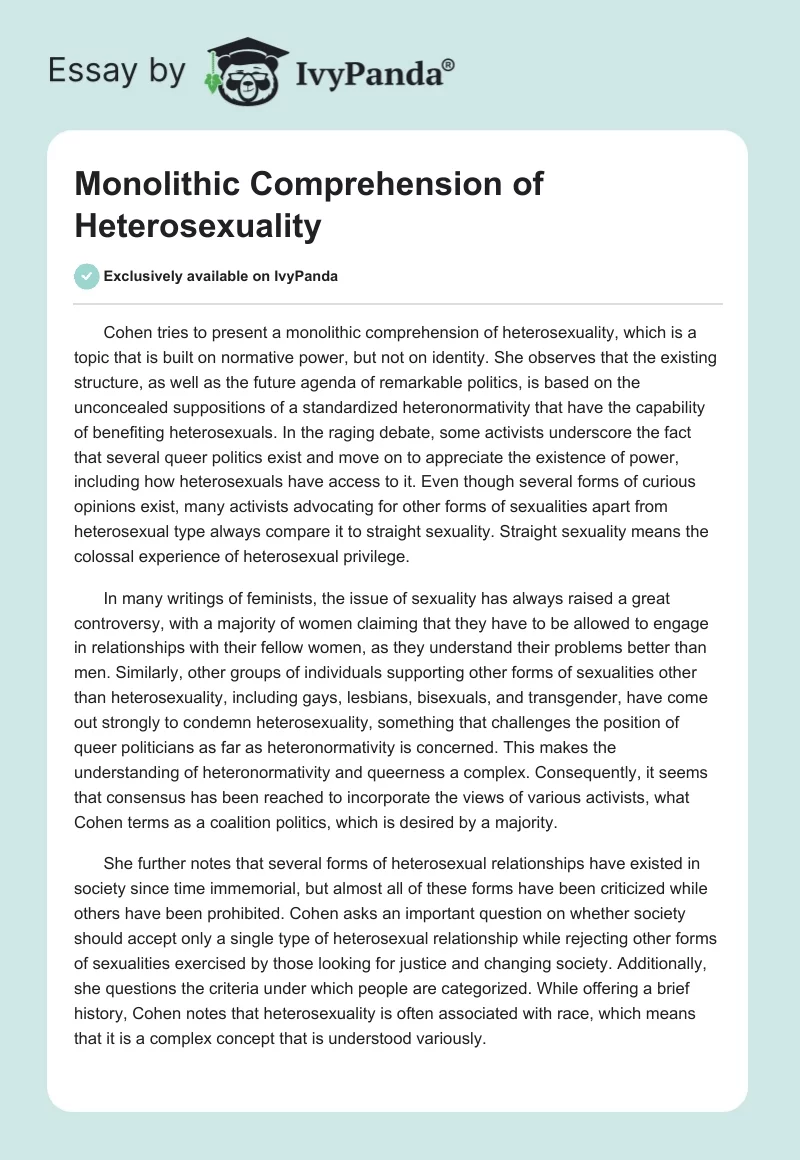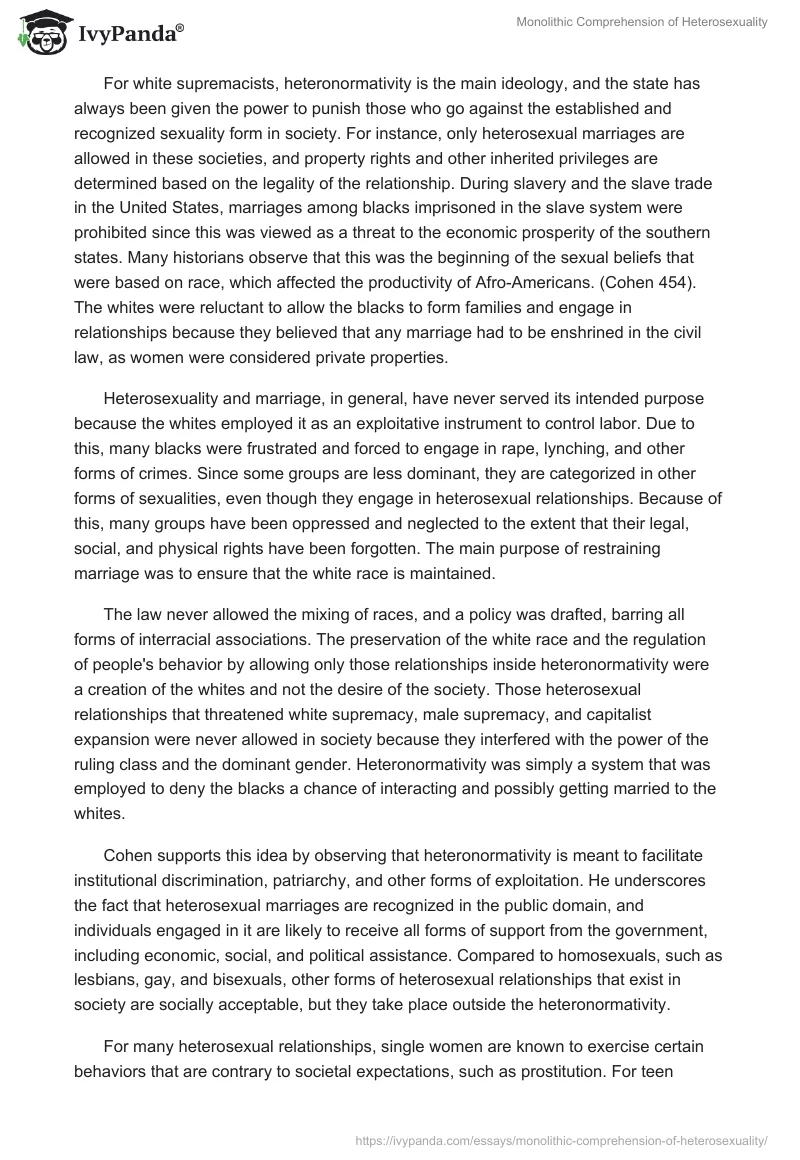Cohen tries to present a monolithic comprehension of heterosexuality, which is a topic that is built on normative power, but not on identity. She observes that the existing structure, as well as the future agenda of remarkable politics, is based on the unconcealed suppositions of a standardized heteronormativity that have the capability of benefiting heterosexuals. In the raging debate, some activists underscore the fact that several queer politics exist and move on to appreciate the existence of power, including how heterosexuals have access to it. Even though several forms of curious opinions exist, many activists advocating for other forms of sexualities apart from heterosexual type always compare it to straight sexuality. Straight sexuality means the colossal experience of heterosexual privilege.
In many writings of feminists, the issue of sexuality has always raised a great controversy, with a majority of women claiming that they have to be allowed to engage in relationships with their fellow women, as they understand their problems better than men. Similarly, other groups of individuals supporting other forms of sexualities other than heterosexuality, including gays, lesbians, bisexuals, and transgender, have come out strongly to condemn heterosexuality, something that challenges the position of queer politicians as far as heteronormativity is concerned. This makes the understanding of heteronormativity and queerness a complex. Consequently, it seems that consensus has been reached to incorporate the views of various activists, what Cohen terms as a coalition politics, which is desired by a majority.
She further notes that several forms of heterosexual relationships have existed in society since time immemorial, but almost all of these forms have been criticized while others have been prohibited. Cohen asks an important question on whether society should accept only a single type of heterosexual relationship while rejecting other forms of sexualities exercised by those looking for justice and changing society. Additionally, she questions the criteria under which people are categorized. While offering a brief history, Cohen notes that heterosexuality is often associated with race, which means that it is a complex concept that is understood variously.
For white supremacists, heteronormativity is the main ideology, and the state has always been given the power to punish those who go against the established and recognized sexuality form in society. For instance, only heterosexual marriages are allowed in these societies, and property rights and other inherited privileges are determined based on the legality of the relationship. During slavery and the slave trade in the United States, marriages among blacks imprisoned in the slave system were prohibited since this was viewed as a threat to the economic prosperity of the southern states. Many historians observe that this was the beginning of the sexual beliefs that were based on race, which affected the productivity of Afro-Americans. (Cohen 454). The whites were reluctant to allow the blacks to form families and engage in relationships because they believed that any marriage had to be enshrined in the civil law, as women were considered private properties.
Heterosexuality and marriage, in general, have never served its intended purpose because the whites employed it as an exploitative instrument to control labor. Due to this, many blacks were frustrated and forced to engage in rape, lynching, and other forms of crimes. Since some groups are less dominant, they are categorized in other forms of sexualities, even though they engage in heterosexual relationships. Because of this, many groups have been oppressed and neglected to the extent that their legal, social, and physical rights have been forgotten. The main purpose of restraining marriage was to ensure that the white race is maintained.
The law never allowed the mixing of races, and a policy was drafted, barring all forms of interracial associations. The preservation of the white race and the regulation of people’s behavior by allowing only those relationships inside heteronormativity were a creation of the whites and not the desire of the society. Those heterosexual relationships that threatened white supremacy, male supremacy, and capitalist expansion were never allowed in society because they interfered with the power of the ruling class and the dominant gender. Heteronormativity was simply a system that was employed to deny the blacks a chance of interacting and possibly getting married to the whites.
Cohen supports this idea by observing that heteronormativity is meant to facilitate institutional discrimination, patriarchy, and other forms of exploitation. He underscores the fact that heterosexual marriages are recognized in the public domain, and individuals engaged in it are likely to receive all forms of support from the government, including economic, social, and political assistance. Compared to homosexuals, such as lesbians, gay, and bisexuals, other forms of heterosexual relationships that exist in society are socially acceptable, but they take place outside the heteronormativity.
For many heterosexual relationships, single women are known to exercise certain behaviors that are contrary to societal expectations, such as prostitution. For teen mothers, who are categorized under heterosexual relationships, they are stigmatized and demonized because of their reluctance to abstain from sex. Poor African women are fond of giving birth to children whose fathers are unknown, and it is often concluded that they conceive the pregnancies through prostitution. Some of these mothers find it difficult to bring up their children because they lack the basic commodities that are critical in the proper upbringing of their children. In American society, such mothers are perceived as a burden because they depend on social programs for survival.
In reality, society is not against various heterosexual relationships that always exist, but of much concern, it is the non-normative sexual behavior that is always under fire from queer activists. Unfortunately, these activists are never mindful of race, class, and gender when making their conclusions on heterosexuals living outside the heteronormativity. In other words, the statement means that those who engage in heterosexual relationships without making them formal operate outside the heteronormativity because the law does not recognize their unions. The state has only one role to play as far as promotion of marriage and relationship in society is concerned, which is providing an enabling environment that would help each individual, irrespective of the sexuality, exercise his or her right, including the right to choose a marriage partner.
Cohen shows that the idea of heteronormativity was mainly created to lockout blacks from engaging in relationships since this would temper with the white race and reduce the productivity of blacks. Therefore, privileging certain populations and regulating the behaviors of others as regards sexuality are uncalled for, and any government should desist from making such attempts. Dorothy Roberts is concerned with the actions of the state pertaining to make blacks procure abortions forcefully. She suggests that the law should allow black women to abort whenever they feel necessary, but they should not be forced to undertake family planning measures.
Works Cited
Cohen, Cathy. “Punks, Bulldaggers, and Welfare queens, the radical potential of queer politics.” Journal of Lesbian and Gay Studies, 3.4 (1997): 437-465. Print.


